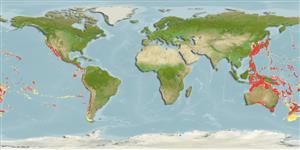分类 / Names
俗名 | 同种异名 | Catalog of Fishes(属, 种) | ITIS | CoL | WoRMS | Cloffa
Elasmobranchii
板鳃亚纲 (鲨鱼与 鱼) (sharks and rays) >
Echinorhiniformes (Bramble sharks) >
Echinorhinidae (Bramble sharks)
Etymology: Echinorhinus: echinos (Gr.), spiny or sea urchin, referring to thorn-like denticles (brambles) on body; rhinus, an ancient name for sharks, from rhine (Gr.), rasp, alluding to a shark’s jagged, rasp-like skin. (See ETYFish); cookei: In honor of the “distinguished conchologist” Charles Montague Cook, Jr. (1874-1948), Bishop Museum (Honolulu), for his “helpful assistance” with Pietschmann’s work (per Pietschmann 1930). (See ETYFish).
Environment: milieu / climate zone / depth range / distribution range
生态学
海洋 底中水层性; 深度上下限 11 - 1100 m (Ref. 26346), usually 70 - ? m (Ref. 6871). 亞熱帶的; 47°N - 55°S, 119°E - 68°W (Ref. 54428)
Western Pacific: Japan (Ref. 6871), Taiwan, Palau, Australia (Ref. 6871) and New Zealand. Eastern Pacific: Hawaii, USA, Gulf of California, and from Costa Rica to Peru and Chile (Ref. 13564). Also reported in Nicaragua (Ref. 13613).
西太平洋: 日本 (參考文獻 6871) ,台灣,帛琉,澳洲 (參考文獻 6871) 與紐西蘭。 東太平洋: 夏威夷,美國,加州灣, 與從哥斯大黎加到祕魯與智利.(參考文獻 13564) 也在尼加拉瓜報告。 (參考文獻 13613)
Length at first maturity / 大小 / 重量 / 年龄
Maturity: Lm 275.0, range 250 - 300 cm
Max length : 400 cm TL 雄鱼/尚未辨别雌雄; (Ref. 247)
背棘 (总数) : 0; 臀棘: 0; 脊椎骨: 89. The prickly shark Echinorhinus cookei has thorn-like denticles on body which are moderately large (single denticles up to about 4mm in basal diameter in adults), numerous, regularly distributed, with scalloped basal margins, and never fused into compound plates. Grayish brown in color, with black distal fin margins; white around mouth and on ventral surface of snout. Tooth count 21-23/20-22. Total vertebrae 89; precaudal 59. As with the other member of the family Echinorhinidae, it has a relatively short snout and stout body; two small spineless dorsal fins, close together, towards posterior part of body and originating behind pelvic fin origin. No anal fin and subterminal notch on caudal fin. Small spiracles, very short labial furrows and teeth on both jaws alike, with a central oblique bladelike cusps with up to 3 cusplets on each side (absent in juveniles) (Ref. 247, 6871).
多刺的鲨鱼 笠鳞鲛[Echinorhinus cookei] 有在身体上的像刺一样的细齿那是中等大的 (单一细齿达到大约在基部的直径中的 4 mm 当成鱼时) ,很多的, 经常地分布了, 与有荷叶边的基部边缘, 而且从不融合成复合的碟。 浅灰褐色的颜色, 有黑色的末梢部的鳍边缘; 嘴的周围与在吻的腹面上的白色。 牙齿数目 21-23/20-22. 脊椎骨总数 89; 尾前椎 59. 与棘鲨科的另一个成员相较, 它有一个相当短的吻与矮胖的身体; 二个小的无棘背鳍, 靠拢在一起, 向身体后部而且在腹鳍起点后面开始。 没有在尾鳍上的臀鳍与接近端位的凹槽。 小的呼吸孔, 非常短的唇沟而且一样牙齿在双颚, 具有一个中央的斜角刀状尖端在两边 (不存在于稚鱼) 上多达 3 cusplets.(参考文献 247,6871)
A large, sluggish shark occurring on continental and insular shelves and upper slopes (Ref. 247). Feeds on a variety of fishes, other sharks, octopi and squids (Ref. 13564). Ovoviviparous (Ref. 205), with up to 114 in a litter (Ref. 26346).
出现于大陆棚与岛屿棚与上层斜坡上的一只大又缓动性的鲨鱼.(参考文献 247) 吃多种鱼,其他的鲨鱼,章鱼与乌贼。 (参考文献 13564) 卵胎生的 (参考文献 205), 多达 114 一胎.(参考文献 26346)
Presumably ovoviviparous (Ref. 6871) with up to 114 in a litter (Ref. 26346).Distinct pairing with embrace (Ref. 205). Size at birth 40-45 cm. Some males mature by 198 cm; females mature between 250 and 300 cm (Ref. 6871).西太平洋: 日本 (參考文獻 6871) ,台灣,帛琉,澳洲 (參考文獻 6871) 與紐西蘭。 東太平洋: 夏威夷,美國,加州灣, 與從哥斯大黎加到祕魯與智利.(參考文獻 13564) 也在尼加拉瓜報告。 (參考文獻 13613)
Compagno, L.J.V., 1984. FAO Species Catalogue. Vol. 4. Sharks of the world. An annotated and illustrated catalogue of shark species known to date. Part 1 - Hexanchiformes to Lamniformes. FAO Fish. Synop. 125(4/1):1-249. Rome, FAO. (Ref. 247)
人类利用
渔业: 低经济
工具
特别资料
下载 XML
网络资源
Estimates based on models
Preferred temperature (Ref.
123201): 3.8 - 19.5, mean 12.1 °C (based on 522 cells).
Phylogenetic diversity index (Ref.
82804): PD
50 = 1.0000 [Uniqueness, from 0.5 = low to 2.0 = high].
Bayesian length-weight: a=0.00363 (0.00139 - 0.00949), b=3.13 (2.90 - 3.36), in cm total length, based on LWR estimates for this (Sub)family-body shape (Ref.
93245).
营养阶层 (Ref.
69278): 4.4 ±0.76 se; based on food items.
回复力 (Ref.
120179): 低的, 最小族群倍增时间4.5 - 14 年 (Fec assumed to be <100).
Fishing Vulnerability (Ref.
59153): Very high vulnerability (90 of 100).
Nutrients (Ref.
124155): Calcium = 6.19 [1.46, 29.11] mg/100g; Iron = 0.439 [0.108, 1.332] mg/100g; Protein = 19.7 [17.9, 21.5] %; Omega3 = 0.244 [0.092, 0.736] g/100g; Selenium = 56.1 [16.6, 203.8] μg/100g; VitaminA = 10 [3, 45] μg/100g; Zinc = 0.382 [0.183, 0.729] mg/100g (wet weight);
